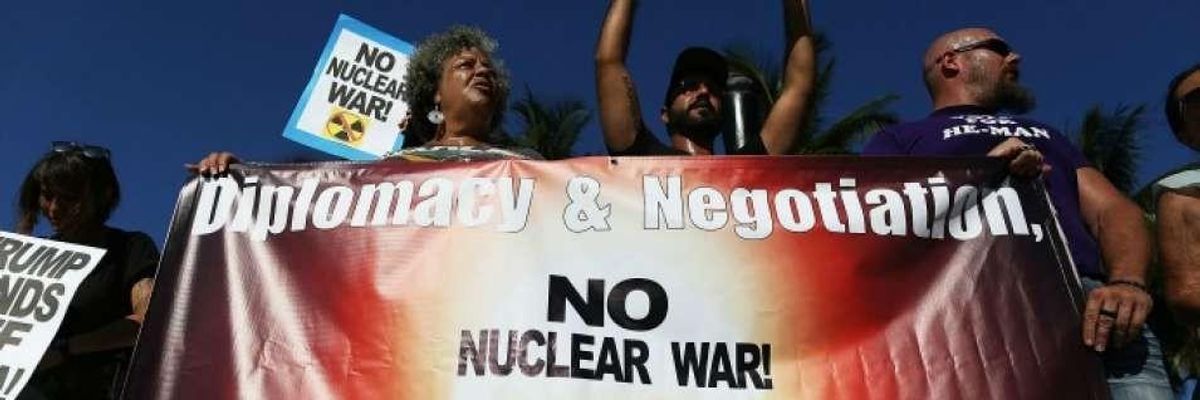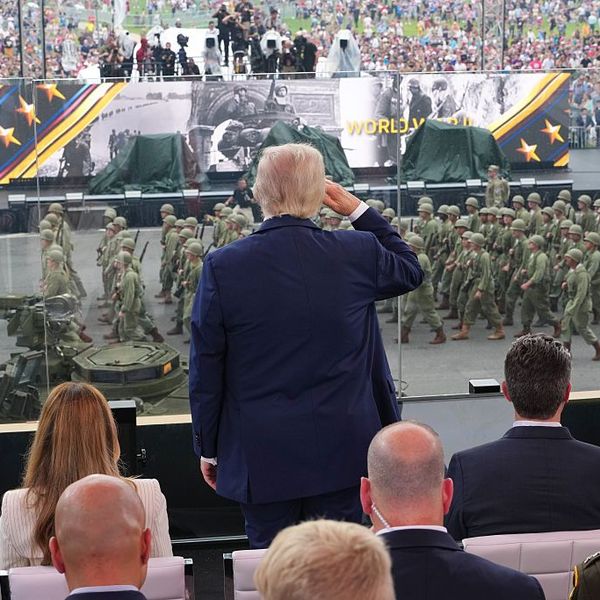
Demonstrators attend a protest demanding nuclear disarmament. (Photo: Joe Raedle/Getty Images)
Experts Warn Trump's New 'Low-Yield' Warheads Will Make Nuclear War More Likely
"This is why we need to eliminate all nuclear weapons. This is why we need responsible states to join the nuclear ban."
Warning that the U.S. is already engaging in a new nuclear arms race as officials announced the development of a new "low-yield" warhead, nuclear disarmament campaigners ramped up their calls Monday for nations to sign on to an international treaty prohibiting the use of nuclear weapons.
The National Nuclear Security Administration (NNSA) announced that the U.S. has begun manufacturing the new weapon, the W76-2, and that the first batch of missiles is set to be delivered to the U.S. military by October 2019. The warhead will give new so-called "flexibility" to Trident missiles, making it easier for President Donald Trump--a future presidents--to deploy the weapons.
The International Campaign to Abolish Nuclear Weapons (ICAN) wrote on Twitter that the availability of such a weapon will make nuclear war even more likely than it has been under President Donald Trump.
\u201cThis is why we need to eliminate all nuclear weapons. This is why we need responsible states to join the #nuclearban asap \u2192 https://t.co/baSflkWLuU\u201d— ICAN (@ICAN) 1548670700
The "low-yield U.S. Trident [will] make first use more likely" by the Trump administration, ICAN researcher Stuart Casey-Maslen wrote.
The Trump administration has pushed for the development of a low-yield weapon that would destroy a smaller area than its existing warheads, writing in its Nuclear Posture Review (NPR) last year that such warheads would make nuclear deployment by adversaries "less likely."
But according to the Guardian, critics including Stephen Young of the Union for Concerned Scientists (UCS) say that a weapon which is easier to deploy is an especially dangerous development with Trump in office, putting the globe at the mercy of "a president who takes pride in his unpredictability and has literally asked: 'Why can't we use our nuclear weapons?'"
The explosive power of the W76-2 is expected to be about five kilotons of TNT--a third of the power of the bomb the U.S. launched at Hiroshima in 1945, making it still incredibly destructive.
Trump has shown a disconcerting willingness to engage in nuclear war--hiring former Reagan and Bush official John Bolton as his National Security Adviser. Bolton has pushed the president to withdraw from the 1987 Intermediate-range Nuclear Forces (INF) treaty with Russia. Trump is expected to announce this coming weekend that the U.S. is suspending its compliance with the treaty, accusing Russia of violating the agreement.
"Frankly, mission creep is my greatest worry" regarding the development of a new low-yield warhead, Hans Kristensen of the Federation of American Scientists told the Guardian. "To what extent does this signal a new willingness on the part of the U.S. to start using strategic nuclear weapons in a tactical and very limited way early in a potential conflict?"
An Urgent Message From Our Co-Founder
Dear Common Dreams reader, The U.S. is on a fast track to authoritarianism like nothing I've ever seen. Meanwhile, corporate news outlets are utterly capitulating to Trump, twisting their coverage to avoid drawing his ire while lining up to stuff cash in his pockets. That's why I believe that Common Dreams is doing the best and most consequential reporting that we've ever done. Our small but mighty team is a progressive reporting powerhouse, covering the news every day that the corporate media never will. Our mission has always been simple: To inform. To inspire. And to ignite change for the common good. Now here's the key piece that I want all our readers to understand: None of this would be possible without your financial support. That's not just some fundraising cliche. It's the absolute and literal truth. We don't accept corporate advertising and never will. We don't have a paywall because we don't think people should be blocked from critical news based on their ability to pay. Everything we do is funded by the donations of readers like you. Will you donate now to help power the nonprofit, independent reporting of Common Dreams? Thank you for being a vital member of our community. Together, we can keep independent journalism alive when it’s needed most. - Craig Brown, Co-founder |
Warning that the U.S. is already engaging in a new nuclear arms race as officials announced the development of a new "low-yield" warhead, nuclear disarmament campaigners ramped up their calls Monday for nations to sign on to an international treaty prohibiting the use of nuclear weapons.
The National Nuclear Security Administration (NNSA) announced that the U.S. has begun manufacturing the new weapon, the W76-2, and that the first batch of missiles is set to be delivered to the U.S. military by October 2019. The warhead will give new so-called "flexibility" to Trident missiles, making it easier for President Donald Trump--a future presidents--to deploy the weapons.
The International Campaign to Abolish Nuclear Weapons (ICAN) wrote on Twitter that the availability of such a weapon will make nuclear war even more likely than it has been under President Donald Trump.
\u201cThis is why we need to eliminate all nuclear weapons. This is why we need responsible states to join the #nuclearban asap \u2192 https://t.co/baSflkWLuU\u201d— ICAN (@ICAN) 1548670700
The "low-yield U.S. Trident [will] make first use more likely" by the Trump administration, ICAN researcher Stuart Casey-Maslen wrote.
The Trump administration has pushed for the development of a low-yield weapon that would destroy a smaller area than its existing warheads, writing in its Nuclear Posture Review (NPR) last year that such warheads would make nuclear deployment by adversaries "less likely."
But according to the Guardian, critics including Stephen Young of the Union for Concerned Scientists (UCS) say that a weapon which is easier to deploy is an especially dangerous development with Trump in office, putting the globe at the mercy of "a president who takes pride in his unpredictability and has literally asked: 'Why can't we use our nuclear weapons?'"
The explosive power of the W76-2 is expected to be about five kilotons of TNT--a third of the power of the bomb the U.S. launched at Hiroshima in 1945, making it still incredibly destructive.
Trump has shown a disconcerting willingness to engage in nuclear war--hiring former Reagan and Bush official John Bolton as his National Security Adviser. Bolton has pushed the president to withdraw from the 1987 Intermediate-range Nuclear Forces (INF) treaty with Russia. Trump is expected to announce this coming weekend that the U.S. is suspending its compliance with the treaty, accusing Russia of violating the agreement.
"Frankly, mission creep is my greatest worry" regarding the development of a new low-yield warhead, Hans Kristensen of the Federation of American Scientists told the Guardian. "To what extent does this signal a new willingness on the part of the U.S. to start using strategic nuclear weapons in a tactical and very limited way early in a potential conflict?"
Warning that the U.S. is already engaging in a new nuclear arms race as officials announced the development of a new "low-yield" warhead, nuclear disarmament campaigners ramped up their calls Monday for nations to sign on to an international treaty prohibiting the use of nuclear weapons.
The National Nuclear Security Administration (NNSA) announced that the U.S. has begun manufacturing the new weapon, the W76-2, and that the first batch of missiles is set to be delivered to the U.S. military by October 2019. The warhead will give new so-called "flexibility" to Trident missiles, making it easier for President Donald Trump--a future presidents--to deploy the weapons.
The International Campaign to Abolish Nuclear Weapons (ICAN) wrote on Twitter that the availability of such a weapon will make nuclear war even more likely than it has been under President Donald Trump.
\u201cThis is why we need to eliminate all nuclear weapons. This is why we need responsible states to join the #nuclearban asap \u2192 https://t.co/baSflkWLuU\u201d— ICAN (@ICAN) 1548670700
The "low-yield U.S. Trident [will] make first use more likely" by the Trump administration, ICAN researcher Stuart Casey-Maslen wrote.
The Trump administration has pushed for the development of a low-yield weapon that would destroy a smaller area than its existing warheads, writing in its Nuclear Posture Review (NPR) last year that such warheads would make nuclear deployment by adversaries "less likely."
But according to the Guardian, critics including Stephen Young of the Union for Concerned Scientists (UCS) say that a weapon which is easier to deploy is an especially dangerous development with Trump in office, putting the globe at the mercy of "a president who takes pride in his unpredictability and has literally asked: 'Why can't we use our nuclear weapons?'"
The explosive power of the W76-2 is expected to be about five kilotons of TNT--a third of the power of the bomb the U.S. launched at Hiroshima in 1945, making it still incredibly destructive.
Trump has shown a disconcerting willingness to engage in nuclear war--hiring former Reagan and Bush official John Bolton as his National Security Adviser. Bolton has pushed the president to withdraw from the 1987 Intermediate-range Nuclear Forces (INF) treaty with Russia. Trump is expected to announce this coming weekend that the U.S. is suspending its compliance with the treaty, accusing Russia of violating the agreement.
"Frankly, mission creep is my greatest worry" regarding the development of a new low-yield warhead, Hans Kristensen of the Federation of American Scientists told the Guardian. "To what extent does this signal a new willingness on the part of the U.S. to start using strategic nuclear weapons in a tactical and very limited way early in a potential conflict?"

